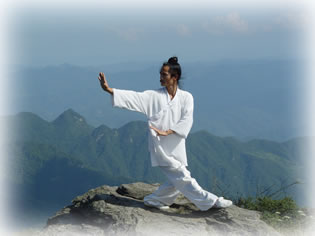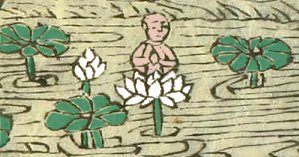"Lieh Tzu could ride the wind and go soaring around with cool and breezy skill, but after fifteen days he came back to earth." - Daoist Sage ZhuangZi, Chapter 1.
"Who realises here in this world the destruction of his sorrow,
Who has laid the burden aside and is emancipated — I call a Saint." - Dhammapada, 402.
"Walk like a free person. Put things down, don’t
carry anything, and feel light. There is a burden we always carry with
us. The skill we need is how to lay down our burden in order to be
light. If you sit, walk, or lie down like that, it’s very easy to
release the tension and reduce the pain" - Vietnamese Zen teacher Thich Nhat Hanh, Shambhala Sun Magazine (January 2012), Imagine a Pine Tree, p44.
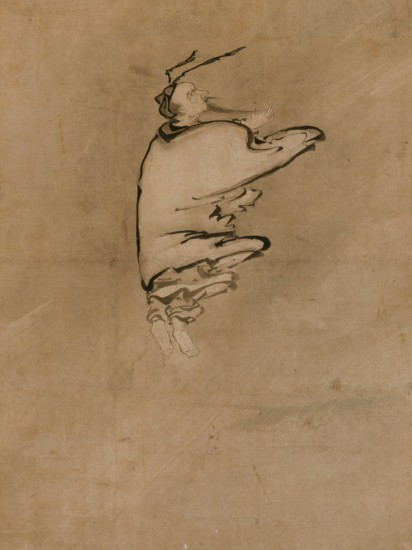 |
| Liezi, the Chinese philosopher and Daoist master of the Spring and Autumn Period. By Japanese artist Sesson Shukei (1504-1589). |
It seems there is a long tradition of associating meditation with lightness - from alleged levitating yogis and dropping attachments to material possessions, to learning how to 'somersault through the clouds' and attend the mythical Jade Emperor's court in heaven.
There is an apparent other kind of lightness that can be practiced and gained through meditation, however - something more to do with how one perceives and interacts with the world. Dropping one's negative judgements regarding difficulties in life, and meeting them in the moment, could also mean releasing oneself from one's burdens. As the Buddha stated in the
Dhammapada (Narada translation), Chapter 7, 2-3 [or 91-92]:
"The mindful exert themselves. To no abode are they attached. Like swans
that quit their pools, home after home they abandon (and go).
They for whom there is no accumulation, who reflect well over their
food, who have Deliverance which is Void and Signless, as their
object—their course, like that of birds in the air, cannot be traced."
First, however, it seems to be necessary that we identify that we are carrying burdens at all. As Vietnamese Zen teacher
Thich Nhat Hanh, in his book
The Heart of Buddha's Teaching (1998), writes, p29:
"The Buddha said that to suffer and not know that we are suffering is
more painful than the burden endured by a mule carrying an unimaginably
heavy load. We must, first of all, recognize that we are suffering and
then determine whether its basis is physical, physiological, or
psychological. Our suffering needs to be identified."
The choice of calling painful experiences 'a burden' can become a toxic habit it seems. There emerges an endless stream of sufferable experiences. American Zen teacher,
Charlotte Joko Beck, writes of this situation in
Nothing Special - Living Zen (1995), p21:
"Burdens are always turning up in our lives. For example, suppose I
have to spend some time with somebody I don’t like, and that feels like a
burden. Or I have a tough week coming up, and I’m discouraged by
it. Or the classes I’m teaching this semester have unprepared students
in them. Raising kids can make us feel burdened. Illness, accidents,
whatever difficulties we meet can be felt to be burdens. We cannot live
as human beings without meeting difficulties, which we can choose to
call “burdens.” Life then becomes heavy, heavy, heavy."
This stream can turn into a river, and even an ocean, in which we feel we are merely treading water. Thich Nhat Hanh writes of such experiences in
The Heart of Buddha's Teaching, p250:
"Sometimes we feel as though we are drowning in the ocean
of suffering, carrying the burden of all social injustice of all times."
Peoples' idea of carrying the collective burden of society is also mentioned by Mindfulness meditation teacher,
Dr Jon Kabat-Zinn, in his book
The Mindful Way Through Depression (2007), p97:
""I feel the weight of the world on my shoulders," we sometimes say. We
may be more familiar with that sensation than many others and certainly
more often than we'd like. This is how many of us feel when depressed or
unhappy-as if a huge burden has been placed on the body, making every
normal action an effort."
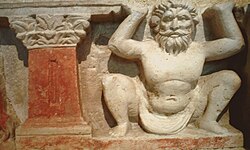 |
| The Ancient Greek Titan Atlas supporting a Greco-Buddhist monument (100-200 BC) in Hadda, Afghanistan. |
It seems most people often react to such situations in unhealthy ways. Charlotte Joko Beck, while using the Greek myth of King
Sisyphus, who was punished by being compelled to perpetually roll an immense boulder up a hill, illustrates how we tend to view our lives of burden, and how often we seek to escape our responsibilities, in
Nothing Special Living Zen, p18:
"The weight of the boulder, the burden, is the thought that our life is a
struggle, that it should be other than it is. When we judge our burden
to be unpleasant, we look for ways to escape. Perhaps one person gets
drunk to forget about pushing the boulder. Another manipulates people
into helping push it. Often we try to shift the burden onto someone else
so we can escape the work."
When we experience the emotional fallout resulting from our unhealthy habits, however, this can add to the burden of suffering we are already experiencing; thus making the situation even worse. As Dr. Kabat-Zinn says in his book
Full Catastrophe Living (2005), p326:
"as the emotional upheavals come and go or our bad feelings linger and weigh on us"
We can get angry and lash out at the world for burdening us so, and yet by doing this we often say and do things which we eventually regret - things which weigh heavy on our hearts. Again this is counterproductive. Thich Nhat Hanh says of this, in
The Heart of Buddha's Teaching, p79:
"The fire of anger
burns in us day and night and causes us to suffer — even more than the
one at whom we are angry. When anger is absent, we feel light and free."
And from
The Sutra on the Four Establishments of Mindfulness - Mindfulness Of Mind,a dharma talk given by Thich Nhat Hanh on February 22, 1998 in Plum Village, France:
"There
are days when we feel that our mind is small and narrow, we have not
the capacity to love and to accept. We blame. We are angry. That is
because our mind is narrow. But also, there are days when we can love
everyone; we can accept everyone and feel light."
It seems, however, that one will not often be able to avoid the negative consequences of negative thoughts and emotions unless one actively practices mindful non-judgement of experiences. The author of
Mindfulness for Dummies (2010) says the following on this topic, p153:
"If your mind habitually pops up with negative or unhelpful thoughts,
seeing the thoughts and images as facts has stressful consequences.
However, you can free yourself of this burden. Switch things round and
try seeing thoughts as automatic, conditioned reactions rather than
facts. Question the validity of thoughts and images. Step back from the
thoughts if you can and don’t take them to be you, or reality. Just
watch them come and go and observe the effect of this."
And here is Kabat-Zinn in
The Mindful Way Through Depression, p229:
"At different times, we certainly will encounter restlessness,
frustration, and impatience, as well as many other mind states and body
states. That is not a problem at all, as long as we remember that it is
possible to hold it all lightly in awareness in any moment."
Some of us have had more traumatic experiences than others, and can easily feel overwhelmed by the burdens we shoulder. Kabat-Zinn writes of such emotional pain as follows, in
Full Catastrophe Living, p319:
"We may carry one kind of emotional pain or another deep within our
hearts, often for much of our lives, like a heavy and sometimes secret
burden, at times unknown even to ourselves. Just as with physical pain,
you can be mindful of emotional pain and can use its energy to grow and
heal. The key is to be willing to inquire into your suffering, to
observe it, to open up to it consciously, in the present, and work with
it just as you would with a symptom, with physical pain, or with a
thought that surfaces repeatedly."
As well as making efforts to recognise our suffering for what it really is, we can lower our burdens by taking things one step at a time - even if we have very busy schedules. Kabat Zinn, in
The Mindful Way Through Depression, says this is necessary to reduce stress in our lives, p90:
"We often exhaust ourselves by focusing on all the things we have to do,
not just for this day, but for the weeks or the months ahead. We carry a
burden that doesn't need to be carried. When we deliberately tune in to
just this moment, to what is before us right now, we allow the energy
to come through to complete just this moment's task."
It seems the most effective way to hone the skill of practicing living in the moment, and taking a step back from thoughts, is to drop all physical activity and do seated meditation. This doesn't mean that the heaviness will miraclulously disappear, however. We often carry our habits of judging into every situation we find ourselves in - even to the point of judging our meditation experience. Again; this just adds to the feeling of being burdened. Kabat-Zinn talks of this in
Wherever You Go, There You Are (2004), p55:
"I'm having a bad meditation. ... It's not working for me. I'm no good at this. I'm no good, period. This type of thinking dominates the mind and weighs it down. It's like carrying around a suitcase full of rocks on your head. It feels good to put it down. Imagine how it might feel to suspend all your judging and instead to let each moment be just as it is, without attempting to evaluate it as "good" or "bad." This would be a true stillness, a true liberation."
Japanese Soto Zen teacher
Shunryu Suzuki, also warns of increasing one's burden relative to one's meditation efforts in
Zen Mind, Beginner's Mind (1995), p129:
"...whether or not you attain enlightenment, just to sit in zazen is
enough. When you try to attain enlightenment, then you have a big burden
on your mind. Your mind will not be clear
enough to see things as they are. If you truly see things as they are,
then you will see things as they should be."
 |
| HuangShan Mountain, China. |
Completely detaching oneself during practice - even from the practice itself is essential to living a lighter existence. Again, here is Kabat-Zinn, in Wherever You Go, There You Are, p106:
"When your mind and body collaborate in holding body, time, place, and
posture in awareness, and remain unattached to having it have to be a
certain way, then and only then are you truly sitting."
And in
The Mindful Way Through Depression, p225 :
"Letting go of happiness as a goal can pave the way for happiness to appear on its own."
In letting go of goals, we can just observe what is in the here-and-now without any idea of gaining anything. When practicing this, the breath can serve as a single point of focus wherever we go - maybe this is what was meant by the Daoist Master LieZi "riding the wind". Here is Kabat-Zinn in
The Mindful Way Through Depression again, p198:
"It is helpful to think of the breathing space as a door through which
we can pass from the hot, murky, cramped, "driven" places in our minds
to a lighter, cooler, more accommodating space."
Thich Nhat Hanh, in his book
Present Moment Wonderful Moment (2008), also mentions this potential of the breath to make us feel lighter, p32-33:
"When we breathe out, we say "Ease." Ease means a feeling of not being
pressured, feeling free. Our time is only for breathing and enjoying
breathing. We feel light and free, at ease. We know that breathing is
the most important thing at this moment, so we just enjoy the practice
of breathing."
 |
| Vietnamese Zen teacher Thich Nhat Hanh. |
With this practice focused on the breath, allowing for whatever comes to leave of it's own accord, life can begin to feel easier. It is only if we make effort during meditation practice that we make things difficult for ourselves. Shunryu Suzuki speaks of this in
Zen Mind, Beginner's Mind, p128:
"... if you try to stop your mind or try to go beyond your conscious activity, that will only be another burden for you."
The practice requires a simplifying and stripping away of the unnecessary additional features we impose upon our experiences, so that we no longer feel weighed down. As Kabat-Zinn writes in
Wherever You Go, There You Are, p239:
"...if you stop trying to make yourself into more than you are out of fear that you are less than you are, whoever you really are will be a lot lighter and happier, and easier to live with, too."
It is by no means an easy task, however, to 'just let go' of the excesses we have become habitually used to. Kabat-Zinn gives advice on this in
Full Catastrophe Living, p40:
"If we find it particularly difficult to let go of something because it
has such a strong hold over our mind, we can direct our attention to
what "holding on" feels like. Holding on is the opposite of letting go.
We can become an expert on our own attachments, whatever they may be and
their consequences in our lives, as well as how it feels in those
moments when we finally do let go and what the consequences of that
are."
Another way to make the process of letting go of attachments easier is to become more aware of what we consume, and the associated appetites we carry around with us. Thich Nhat Hanh highlights this potential practice in
The Heart of Buddha's Teaching, p33:
"With the practice of mindfulness, we will know that hearing this,
looking at that, or touching this, we feel light and peaceful, while
hearing that, looking at this, or touching that, we feel anxious, sad,
or depressed. As a result, we will know what to be in contact with and
what to avoid. Our skin protects us from bacteria. Antibodies protect us
from internal invaders. We have to use the equivalent aspects of our
consciousness to protect us from unwholesome sense objects that can
poison us."
Some appetites can be inherited, however, and we may not know how they were established, or whether they can be lessened. This situation could be akin to a 'heroin baby' born of a heroin addict mother - or maybe just 'animal intincts' inherited from times when humans lived in less enlightened societies. Thich Nhat Hanh, in
The Sutra on the Four Establishments of Mindfulness - Mindfulness Of Mind Dharma Talk, speaks of this situation thus:
"When there is craving, we see that this craving can come from our body,
or it can come from our perception, or it could be an inheritance from
our ancestors. And we have to accept this inheritance. We are aware of
it, and we have to transform it. In the list of wholesome mental
formations, the first one is alobha, meaning the absence of desiring. We
all have this mental formation. We only just have to remove the mental
formation of craving and the other one will be there, and we will feel
very close to the Buddha. We will feel light, we will feel free."
He says the way to remove the mental formation of craving is to practice 'Right Mindfulness' and 'Right Concentration', in
The Heart of Buddha's Teaching, p107:
"Right Mindfulness and Right Concentration lift us above the realms of
sensual pleasures and craving, and we find ourselves lighter and
happier. Our world is no longer gross and heavy, the realm of desires
(karma dhatu). It is the realm of fine materiality, the realm of form
(rupa dhatu)."
The author of
Mindfulness in Plain English (2002) writes of this experience relative to the sensation of burdens thus, p175:
"Craving is extinguished and a great burden is lifted.
There remains only an effortless flow, without a trace of resistance or
tension. There remains only peace, and blessed nibbana, the uncreated,
is realized."
As time goes on and one's practice deepens, Charlotte Joko Beck points out that one can measure how fruitful one's efforts have been relative to the feeling of being less burdened in life, in
Nothing Special - Living Zen, p21:
"...the thought that life is a burden is only a concept. We’re simply doing
what we’re doing, second by second by second. The measure of fruitful
practice is that we feel life less as a burden and more as a joy."
Kabat-Zinn relates an example of a mindfulness student experiencing the fruits of his practice in such a way in
The Mindful Way Through Depression, p187:
"Suddenly he was able to relate to unpleasant experiences
as simply bundles of thoughts, feelings, and body sensations.
Identifying less personally with his response to unpleasant events, he
found the whole situation became lighter, more spacious, freer."
And, p225:
"The words "I do not need to be happy" came to him. As he said these
words to himself, David experienced a wonderful sense of lightness come
over him, as if a burden that he had been carrying for too long had
suddenly been lifted from him. And he felt happy !"
The body, along with mind, can also feel physically lighter from practice. Thich Nhat Hanh relates this feature in
The Miracle of Mindfulness (1987), p42:
"Sitting in meditation is nourishment for your spirit and nourishment
for your body, as well. Through sitting, our bodies obtain harmony, feel
lighter, and are more at peace. The path from the observation of your
mind to seeing into your own nature won't be too rough. Once you are
able to quiet your mind, once your feelings and thoughts no longer
disturb you, at that point your mind will begin to dwell in mind."
In the movie
TaiChi Master, which loosely tells the story about the future founder of TaiChi/TaiJi leaving Shaolin Temple and losing his mind after being betrayed by his best friend, illustrates the mindful teachings on lowering one's burden quite nicely in one particular scene. Here is a clip:
Detaching oneself from direct association with the pains of life seems to be a key part of living a lighter, more joyful experience. Kabat-Zinn describes the potential outcome in
Full Catastrophe Living, p283:
"It can feel as if you are completely detached from the sensations you
are experiencing, as if it were not "your" pain so much as just pain.
Perhaps you felt a sense of being calm "within" the pain or "behind" the
pain."
The strongest of such experiences appears to emerge when in seated meditation, and so the peace and calm found within daily seated meditation practice can, unfortunately, become 'addictive' in it's own right - as an escape from the busy world. Kabat-Zinn warns of this potential in
Wherever You Go, There You Are, p74:
"You might be tempted to avoid the messiness of daily living for the
tranquility of stillness and peacefulness. This of course would be an
attachment to stillness, and like any strong attachment, it leads to
delusion. It arrests development and short-circuits the cultivation of
wisdom."
Shunryu Suzuki also speaks of this need to not become attached to the results of practice - that one should always continue as if one is a beginner, in
Zen Mind, Beginner's Mind, p138:
"You can understand Buddha's
teaching exactly as he meant it. But we must not be attached to...
Buddhism, or even to our practice. We must have beginner's mind, free
from possessing anything, a mind that knows everything is in flowing
change. Nothing exists but momentarily in its present form and color.
One thing flows into another and cannot be grasped."
Thich Nhat Hanh, in
The Chant on Protecting and Transforming, Dharma Talk – March 12, 1998, emphasises how this repeated "beginning anew" lightens our being:
"When I have begun anew, I will have a new energy and I will feel light in my heart and my body"
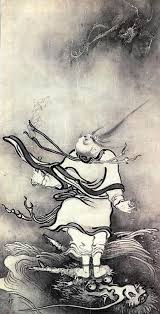 |
| A Daoist flying on a dragon's head. |











